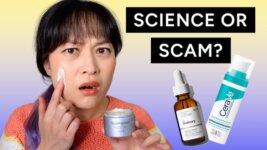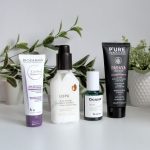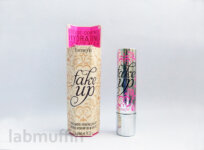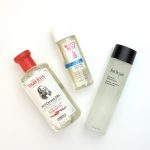I haven’t had a good Cranky Old Lady rant in a while, so here’s one today, ranting about products I hate.
Honestly, it isn’t even the product most of the time – it’s just the marketing around it that I hate.
Video is here on YouTube, keep scrolling for the written version.
Coffee Scrubs
I’ve ranted about coffee scrubs before here.
The short version: coffee scrubs are overpriced, and to convince people to buy them there’s usually a bit of false advertising involved around caffeine and cellulite, stretch marks and scars. There isn’t enough caffeine in coffee grounds (since most of it goes into the coffee you drink) to have much of an effect on cellulite, and caffeine doesn’t have any known effect on stretch marks and scars.
Related post: Do Coffee Scrubs Work Against Cellulite?
Cellulite is a perfectly normal part of women’s bodies (it’s estimated that over 90% of women have it). I think that coffee scrub companies sometimes overstep and pathologise cellulite, and encourages the idea of scrubbing as self-torture for perceived imperfections.
Personally, I also find them really annoyingly messy.
Products protecting against blue light from screens
If you’ve seen my previous content on visible light damage and blue light, you’ll already know why these are BS.
Blue light can potentially have effects on skin. In in vitro studies, it’s been found that blue light can cause skin cells to produce more free radicals, which could theoretically lead to faster skin aging. But this hasn’t been found in any clinical trials yet, and skin cells in a petri dish are very different from skin cells in skin. Clinical studies have also found that darker skin can develop hyperpigmentation with blue light, but the amount that comes from screens is really tiny compared to the amounts used in studies.
Related post: Does Visible Light Cause Skin Damage? And How to Protect Against It
Related post: Will Blue Light from Computers and Phones Damage Your Skin?
The only people who need to be concerned about the tiny amounts of light coming from screens are people with photosensitivity conditions (you’d know if you have one of these because your doctor would have warned you about turning on lights indoors). You would need to sit in front of your screen for days or months to get the same amount of visible light in 15 minutes of sunshine. This sounds kind of scary because we all know that the sun causes skin damage, but the reason we’re scared of the sun is UV, not visible light. Visible light from the sun hasn’t been linked to skin cancer or aging.
So there’s no logical reason why brands selling anti-blue light products should be focusing on screens rather than the sun… but most of them are. Like a lot of other fear-mongering marketing, I think they’re really trying to exploit our bias towards natural things
Related post: Are Natural Beauty Products Better?
We like to think that natural things like the sun are OK, but artificial things like screens and the internet are bad for us in some way, even though they’ve been really beneficial. This is especially the case during this pandemic, where screens have been really crucial for a lot of people – they’ve been helping many of us keep socially connected and able to earn income while staying safe. But a lot of brands have been coming out with these products during lockdown, and I think it’s really opportunistic and somewhat predatory.
A more likely way that blue light from screens might be harming your skin is by messing up your sleep schedule. There’s some evidence that blue light can suppress melatonin, a hormone that induces sleep, but you can reduce this with a (frequently free) blue light filter app, not a skin care product.
Jade rollers and gua sha tools
Facial massage is really nice and soothing – it can help you relax tight muscles, push out lymphatic fluid to make your face look more toned, and cool down your skin. I actually quite enjoy using these massage tools! The problem, again, is the marketing.
These tools tend to really oversell the benefits. You’ll see claims like:
- increase your blood circulation
- helps your skin release toxins
- calms inflammation
- gets rid of wrinkles
- stimulates collagen production
- reduces cell turnover time
- minimises enlarged pores
- boosts elastin
- minimises spots caused by toxin build up
- reduce sagging
Now theoretically, increasing your circulation could possibly lead to increased collagen production, and massaging can increase circulation. But massaging has never been shown to increase collagen production in studies, so they can’t really say this will happen. It’s like saying that because fast food gives you energy and energy makes you run faster, eating lots of fast food would make you a really good athlete. There’s a theoretical mechanism, but without more solid data you can’t confidently make this sort of claim.
I think these tools also rely a lot on exoticism (the whole “ancient Chinese secret” sort of marketing) to sell. I don’t think it’s a coincidence that jade rollers in particular got really popular, and that “gua sha tools” took off rather than facial massage stones.
There’s also a lot of crystal pseudoscience involved. One brand has some incredible claims:
- Rose quartz is an emotional healer, reduces and releases impurities and stress in skin, is really good for detoxing… and somehow this “emotional healer” also helps you with fine lines and wrinkles
- Amethysts are good for calming inflammation and acne
- Red jasper is a stone of vibrancy and endurance and therefore it’s good for hyperpigmentation
I think this crystal stuff is a relatively harmless pseudoscience, but it still has some harms. Medical pseudoscience with healing claims can lead people to delay treatment for their medical conditions, which can mean that it’s a lot harder to treat.
There are also serious issues with how crystals are sourced. A lot of them come from mines with really bad working conditions, with a lack of regulations leading to child labour, serious injuries and unfair pay.
SPF drops
Related post: Product Rant: SPF Sunscreen Drops
I’ve ranted about SPF sunscreen drops are meant to be mixed into other products to turn them into sunscreens, so you don’t have to use a regular sunscreen. Sunscreens don’t always have good textures, and they break a lot of people out (including me), so this is a really appealing product… but like a lot of other really appealing ideas, it doesn’t work.
Sunscreen drops say they have high SPF, but this is for the product applied on its own, not after you’ve mixed it with something else. Mixing a few drops into your foundation or moisturiser means you’ll be diluting it quite a lot.
As I’ve mentioned before, if you dilute a sunscreen, it becomes way less effective. Protection changes roughly linearly, so if you dilute it by half, you end up with half the SPF. 3 drops is about 0.15 mL, so on my face SPF 30-50 drops would give an SPF of 5-10.
Theoretically you could apply them like a regular sunscreen and get the proper amount of protection – but everything about the product encourages you to only apply a few drops: the dropper bottle packaging, the instructions, the tiny size of the bottle, the high cost…
Even if we had a really high protection product (say, SPF 500 drops), it’s still not a good idea to mix products to try to make a sunscreen. How well a sunscreen works isn’t just about how much active ingredient you have – it’s also about how that active ingredient is spread out. There are a lot of things that can impact this: what the other ingredients in your mixed product are, whether or not they interact with each other, how it spreads over your skin, and how it dries (this is why sunscreen is one of the hardest products to formulate). There are a whole bunch of variables that this mixing doesn’t take into account.
If you’re mixing these drops together, you’re probably not mixing them evenly either. You can’t predict how these two products will interact with each other when you mix them (balling up, separating). So you’re probably getting patchy protection with this sort of SPF mix, where some parts of your skin aren’t getting enough protection.
But I guess you’re probably only getting about SPF 5, so maybe it doesn’t even matter. You’re probably better off using a foundation with SPF… and we all know that that isn’t enough. Just use a dedicated sunscreen.
Maybe I’m being a bit harsh, because the products themselves aren’t necessarily bad – it’s mostly how you’re meant to use them and how they’re marketed that make them really bad.
Are you also really annoyed about these products? Are there other products that you also hate?






Really appreciated this whole post,…especially “companies sometimes overstep and pathologise cellulite, and encourages the idea of scrubbing as self-torture for perceived imperfections”. Yes!!!
Cetaphil – it has ingredients that are known to, at best, do nothing for skin, and yet many derm/medical clinics hand out or sell it to patients
It’s not like it does nothing for the skin. I think actually that is one of it’s strong points. It’s gentle. If you talk about the moisturizers, Cetaphil moisturizers are good occlusive products and that’s what you want in a moisturizer anyways. It does it’s job, and it’s tolerated well by people. Idk what one could possibly want from a cream – I’ve used literally I think a thousands different potions, creams, serums, toners – and they all did jack shit in the end. Nothing that I ever used in my life blew me away. Only prescription tretinoin, hydroquinone and lasers (ipl, fraxel) and acid peels made a difference to my skin.
I agree – a lot of the time the people trashing it are selling expensive products. It’s a solid, accessible brand.
Thankyou for having such a refreshing perspective and cutting through the crap (so to speak) Especially during this pandemic where I’ve been prone to falling for claims where common sense should prevail but doesn’t.
And props for mentioning the regulations around crystals and child labour. I admire your ethos and thankyou for your candour.
Hi Michelle,
For the last few months, I’ve been bombarded with messages on WhatsApp over these 2 brands: Aulora pants (which could fix every health condition but cancer) and Dr Secret’s skincare products (which could zapped pimples and hyperpigmentation into oblivion). I am aware of the use of FIR in therapies but FIR is still very new and more evidence is needed. I work in clinical trials and am a pharmacist by training so naturally, the researcher in me became intrigued about these 2 brands. What frustrates me is that no one has the answers to my questions and any so-called results aren’t backed up by scientific evidence (I can’t find any to back up Aulora pants) yet you get people believing this miracle pants. Needless to say, I could not find any papers written by this so-called Dr. Shimizu from Osaka University who write a paper supporting the use of FIR technology in garments and other therapies. These pants are huge in Asia and marketing has penetrated Australian shores. Would be interesting to get your take on these 2 brands: researcher to researcher.
How interesting! I’ll have a look and see if I can find anything… thanks for bringing them to my attention.
I love your work. I must confess, I was tempted into the jade gua sha trend. It fell and broke within a week so that was the end of that. I never even thought of where it was sourced from. Thanks for taking sense!
I totally agree with you about this. But I would like to add some other point of view. As long as a moisturizer does the job done and it works perfectly for you, that’s great. But this days, you can find quite a few with some anti aging ingredients or at least that works againts inflammation witch we know it breaks the collagen in the skin. For example I always look after a mix of niacinamide, acetyl glucosamine, gluconalactone, resveratrol, green tea leaf extract, superoxide dismutase, tocopherol,etc. Beside just keeping my skin moisturized it will also defend againts oxidative stress, sun, decreasing the inflammation and at some point decreasing also de hyperpigmentation. Win win.
Really interesting post! I was really surprised about the blue-light protection products lately. I have been checking some of the papers that claim that blue light (visible lower wavelength) but not red light (higher wavelength) causes skin damage. I find surprising how they perform the experiments, in order to properly irradiate the cells in vitro is really important to do it without any liquid (remove all medium or PBS) to generate results that you can trust or reproduce. If you irradiate the cells with medium, it’s possible that the amount of irradiation that arrives to your cells is lower. For this reason, blue light with a lower wavelength has higher penetrance and, maybe just because of that, has an effect in the cells. However, red light with higher wavelength and lower penetrance doesn’t have an effect… and it could be that it is not arriving to the cells at all!
There’s a lot of marketing talking about these products but more good research is needed indeed!
When okay regeneration came out it was full of salt which dried your skin and made it feel tight